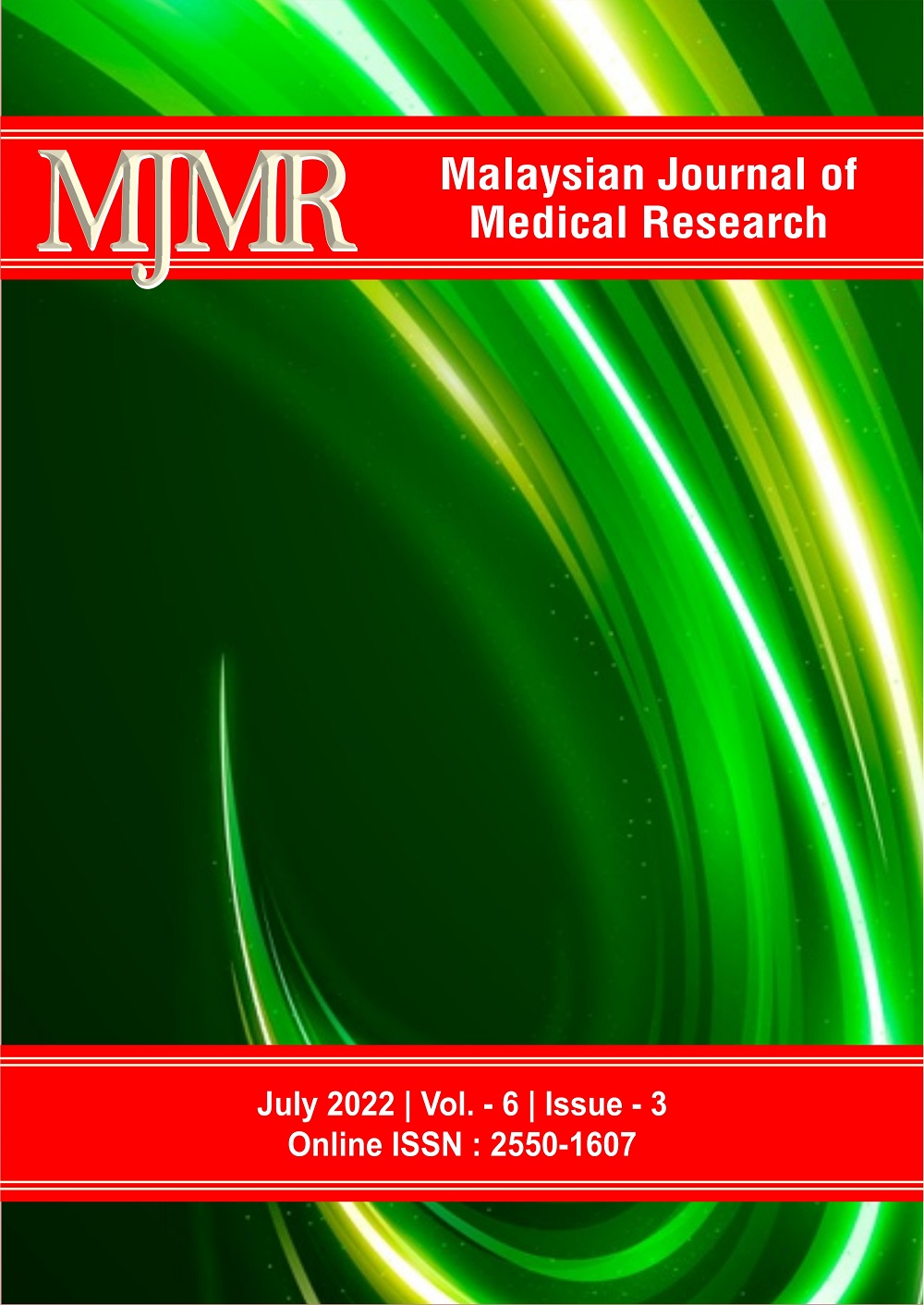The Structural and Social Determinants of Reproductive Behavioural Health
A Brief Appraisal of Indian Scenario
DOI:
https://doi.org/10.31674/mjmr.2022.v6i03.006Abstract
Reproductive health plays a crucial role to maintain a healthy status of an individual. Hence, it is a vital part that an individual has to keep in mind. The term “Reproductive Rights and Reproductive History” was coined in the “International Conference on Population and Development (ICPD)” held in 1994, and the term “Reproductive Health” was connoted as “a state of complete physical, mental and social well-being and not merely the absence of disease or infirmity, in all matters relating to the reproductive system and to its functions and processes”. Collected detailed on reproductive behaviour of an individual now known as “Reproductive history”; is defined as “An important aggregate factor in epidemiological studies of women’s health. The concept usually includes the number and timing of pregnancies and their outcomes, the incidence of breast feeding, and may include age of menarche and menopause, regularity of menstruation, fertility, gynaecological or obstetric problems, or contraceptive usage.” Researchers, epidemiologists, along with medical personnel have chronicled their findings and voiced their concerns in maternal and reproductive health in various platforms at national and international levels. Some of these papers are focused on this topic. In the present discussion an attempt has been made to evaluate the role of structural and social determinants on reproductive health. The systematic analysis might help to pinpoint the populations that seem to be lacking in awareness of the importance of this vital but often ignored part of health and thus there is a lag in the reproductive health services.
Keywords:
Reproductive Health, Women, Structural and Social Determinants, COVID-19 PandemicDownloads
References
Ajith, P (2014). Affordable Health Care Service Innovation From India. Pacific Business Review, 6, 87-94
Beall, C. M., & Leslie, P. W. (2014). Collecting women's reproductive histories. American journal of human biology: the official journal of the Human Biology Council, 26(5), 577–589. https://doi.org/10.1002/ajhb.22543
Deb R. 2010. Knowledge, attitude and practices related to family planning methods among the Khasi Tribes of East Khasi hills Meghalaya. Anthropologist. 12: 41-45. https://doi.org/10.1080/09720073.2010.11891130
Gupta, S. D., Khanna, A., Gupta, R., Sharma, N. K., & Sharma, N. D. (2010). Maternal mortality ratio and predictors of maternal deaths in selected desert districts in rajasthan a community-based survey and case control study. Women's health issues : official publication of the Jacobs Institute of Women's Health, 20(1), 80–85. https://doi.org/10.1016/j.whi.2009.10.003
Hazarika I. (2010). Women's reproductive health in slum populations in India: evidence from NFHS-3. Journal of urban health : bulletin of the New York Academy of Medicine, 87(2), 264–277. https://doi.org/10.1007/s11524-009-9421-0
International Institute for Population Sciences. 2010. District level household and facility survey 2007-08. Mumbai. DLHS-3.
International Institute for Population Sciences and Macro International (2022). National Family Health Survey (NFHS-5), 2019_2020. India. http://rchiips.org/nfhs/NFHS-5Reports/NFHS-5_INDIA_REPORT.pdf
Jungari S. (2020). Maternal mental health in India during COVID-19. Public health, 185, 97–98. https://doi.org/10.1016/j.puhe.2020.05.062.
Kapetanovic, S., Christensen, S., Karim, R., Lin, F., Mack, W. J., Operskalski, E., Frederick, T., Spencer, L., Stek, A., Kramer, F., & Kovacs, A. (2009). Correlates of perinatal depression in HIV-infected women. AIDS patient care and STDs, 23(2), 101–108. https://doi.org/10.1089/apc.2008.0125
Khan, M. M., & Khan, H. (2016). Syrian crisis and its effects on medical community. Gomal Journal of Medical Sciences, 14(1).
Khani, S., Moghaddam-Banaem, L., Mohamadi, E., Vedadhir, A. A., & Hajizadeh, E. (2018). Women's sexual and reproductive health care needs assessment: an Iranian perspective. Eastern Mediterranean health journal = La revue de sante de la Mediterranee orientale = al-Majallah al-sihhiyah li-sharq al-mutawassit, 24(7), 637–643. https://doi.org/10.26719/2018.24.7.637
Koski, A. D., Stephenson, R., & Koenig, M. R. (2011). Physical violence by partner during pregnancy and use of prenatal care in rural India. Journal of health, population, and nutrition, 29(3), 245–254. https://doi.org/10.3329/jhpn.v29i3.7872
Kraft, J. M., Kulkarni, A., Hsia, J., Jamieson, D. J., & Warner, L. (2012). Sex education and adolescent sexual behavior: do community characteristics matter?. Contraception, 86(3), 276–280. https://doi.org/10.1016/j.contraception.2012.01.004
Kumar, M., Meena, J., Sharma, S., Poddar, A., Dhalliwal, V., Modi-Satish Chander Modi, S. C., & Singh, K. (2011). Contraceptive use among low-income urban married women in India. The journal of sexual medicine, 8(2), 376–382. https://doi.org/10.1111/j.1743-6109.2010.02047.x
Lindberg, L. D., & Maddow-Zimet, I. (2012). Consequences of sex education on teen and young adult sexual behaviors and outcomes. The Journal of adolescent health : official publication of the Society for Adolescent Medicine, 51(4), 332–338. https://doi.org/10.1016/j.jadohealth.2011.12.028
Nayar K. R. (2007). Social exclusion, caste & health: a review based on the social determinants framework. The Indian journal of medical research, 126(4), 355–363.
Nachimuthu H, Devi H Karunanithi N 2022: Knowledge, Awareness and Perception on Contraception Among Women of Reproductive Age Attending Senawang Health Clinic. Malaysian Journal of Medical Research,vol 6, No 3.16-27
Noronha, J. A., Bhaduri, A., Vinod Bhat, H., & Kamath, A. (2010). Maternal risk factors and anaemia in pregnancy: a prospective retrospective cohort study. Journal of obstetrics and gynaecology : the journal of the Institute of Obstetrics and Gynaecology, 30(2), 132–136. https://doi.org/10.3109/01443610903267457
Phelan, N., Behan, L. A., & Owens, L. (2021). The Impact of the COVID-19 Pandemic on Women's Reproductive Health. Frontiers in endocrinology, 12, 642755. https://doi.org/10.3389/fendo.2021.642755
Reproductive Health Supplies Coalition.
(2019). Commodity Gap Analysis, https://www.rhsupplies.org/cga/cga_2019_print_version_final.pdf.
Saccone, G., Florio, A., Aiello, F., Venturella, R., De Angelis, M. C., Locci, M., Bifulco, G., Zullo, F., & Di Spiezio Sardo, A. (2020). Psychological impact of coronavirus disease 2019 in pregnant women. American journal of obstetrics and gynecology, 223(2), 293–295. https://doi.org/10.1016/j.ajog.2020.05.003
Sarli, D. (2019). Analysis of Maternal and Perinatal Labour Complications with Mother Who Have Gestational Diabetes Mellitus. Malaysian Journal of Medical Research (MJMR), 3(2), 17-24. https://doi.org/10.31674/mjmr.2019.v03i02.002
Sanneving, L., Trygg, N., Saxena, D., Mavalankar, D., & Thomsen, S. (2013). Inequity in India: the case of maternal and reproductive health. Global health action, 6, 19145. https://doi.org/10.3402/gha.v6i0.19145
Santhya, K. G., Ram, U., Acharya, R., Jejeebhoy, S. J., Ram, F., & Singh, A. (2010). Associations between early marriage and young women's marital and reproductive health outcomes: evidence from India. International perspectives on sexual and reproductive health, 36(3), 132–139. https://doi.org/10.1363/ipsrh.36.132.10
Santhya, K. G., & Jejeebhoy, S. J. (2015). Sexual and reproductive health and rights of adolescent girls: evidence from low- and middle-income countries. Global public health, 10(2), 189–221. https://doi.org/10.1080/17441692.2014.986169
Singh, L., Rai, R. K., & Singh, P. K. (2012). Assessing the utilization of maternal and child health care among married adolescent women: evidence from India. Journal of biosocial science, 44(1), 1–26. https://doi.org/10.1017/S0021932011000472
Soelar, S. A., & Mustaffa, N. A. (2022). A Mixed-Method Analysis of People’s Perception and Behaviour on Vaccination Program in Online Social Media. Malaysian Journal of Medical Research (MJMR), 6(3).
Stanger-Hall, K. F., & Hall, D. W. (2011). Abstinence-only education and teen pregnancy rates: why we need comprehensive sex education in the U.S. PloS one, 6(10), e24658. https://doi.org/10.1371/journal.pone.0024658
Tripathi N. (2021). Does family life education influence attitudes towards sexual and reproductive health matters among unmarried young women in India?. PloS one, 16(1), e0245883. https://doi.org/10.1371/journal.pone.0245883
United Nation. 1994. Report of the International Conference on Population and Development, Cairo.
Wahyuni S.B (2020): The Effect of Using Tutorial Video Learning Media on Mother’s Knowledge and Skills in Giving Prenatal Stimulation. Malaysian Journal of Medical Research (MJMR), 4(4):55-61
World Health Organization. (2009). Quality Assessment Guidebook. A guide to assessing health services for adolescent clients. Geneva.
World Health Organization (WHO) (2015). Health Worker Roles in Providing Safe Abortion Care and Post-Abortion Contraception, http://www.who.int/reproductivehealth/publications/unsafe_abortion/abortion-task-shifting/en/.
Published
How to Cite
Issue
Section
License
Copyright (c) 2022 Malaysian Journal of Medical Research (MJMR)

This work is licensed under a Creative Commons Attribution-NonCommercial-NoDerivatives 4.0 International License.























